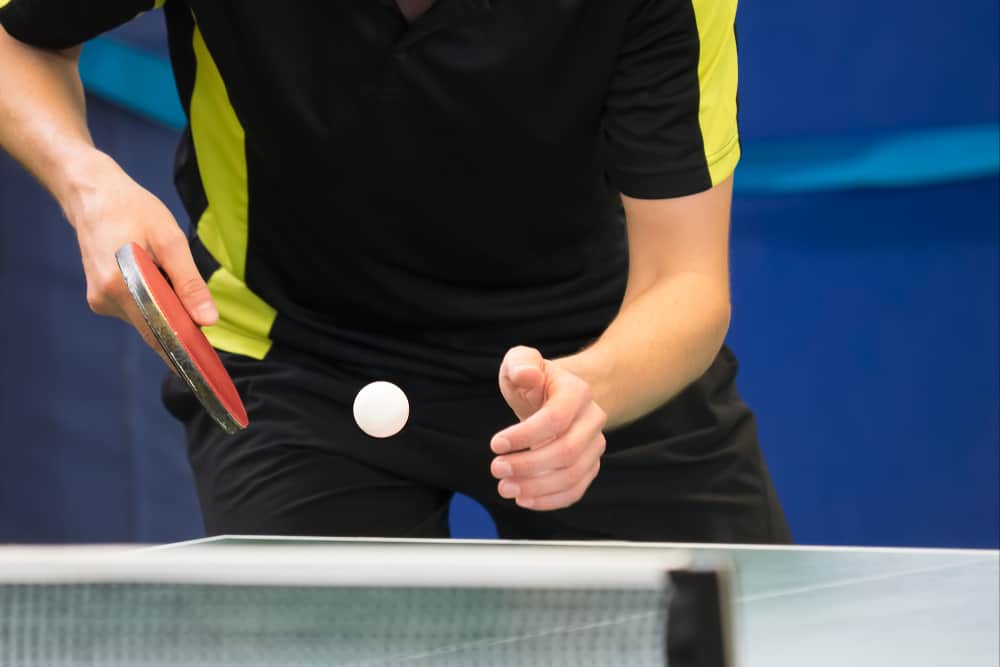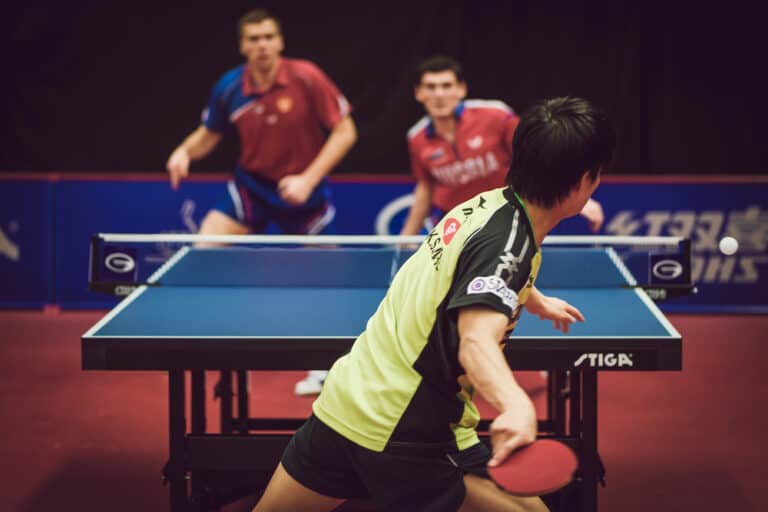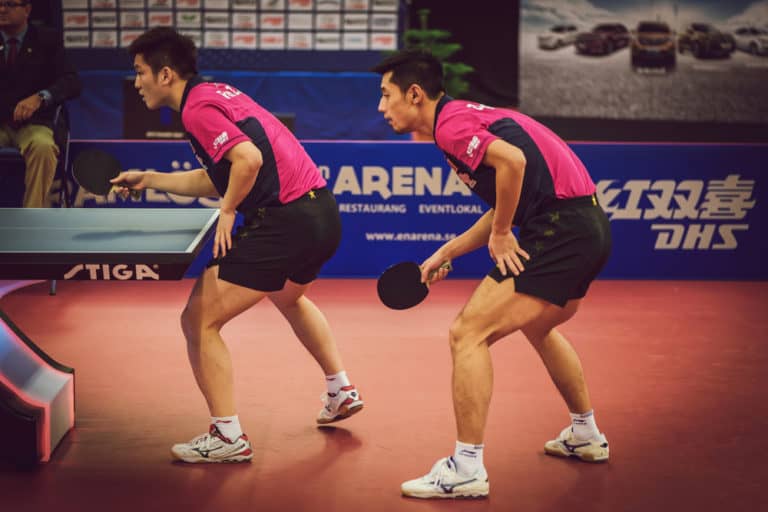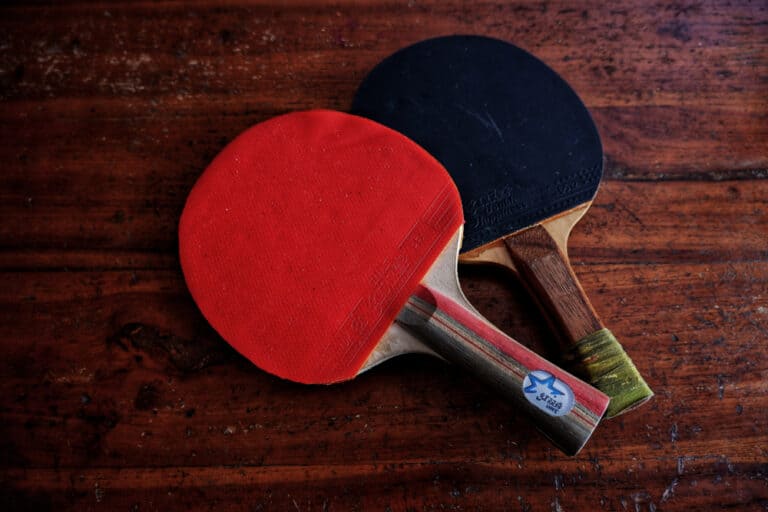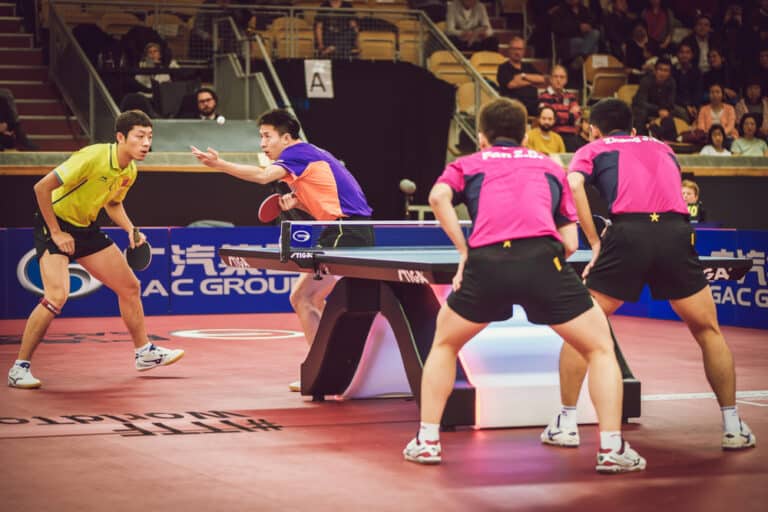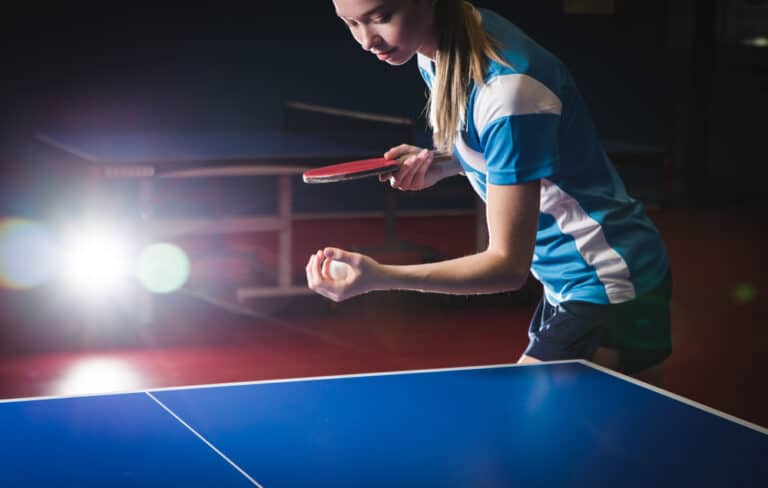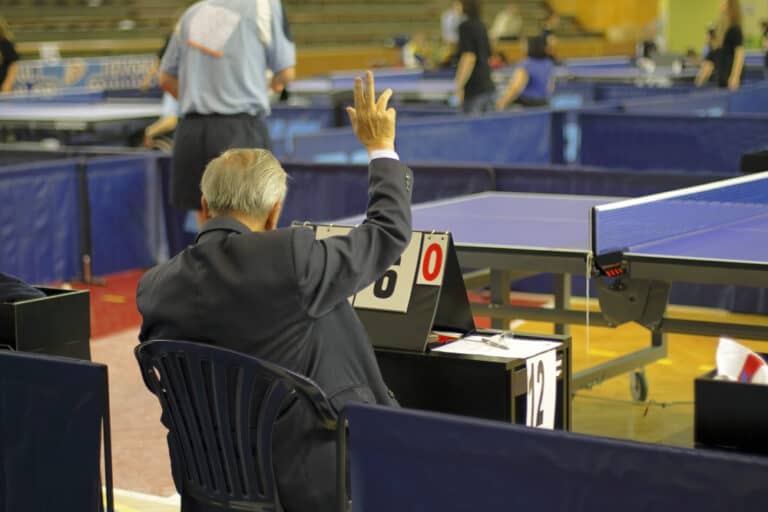What Happens If The Ball Hits You In Table Tennis?
Table tennis is a sport filled with exciting, agile movements and top-level skills. It’s pretty straightforward to pick up for beginners, but specific rules can be a little tricky to understand, especially for those from different sports. I often find myself going back to the handbook to double-check specific rules o answer questions from new players. So, what happens if the ball hits you in table tennis?
If a table tennis ball hits you, you will get the point if it did not bounce on the table and was past the end line, but lose the point if the ball was over the table’s playing surface. If the ball first bounces on the table and then hits you while it’s over the table, you will lose the point.
It’s not always easy to understand the rules in a handbook because they are seldom written for teaching purposes. Fortunately, this article will change that! We’ll cover every scenario in which players get or lose points for body shots. Afterward, we’ll match them to the official table tennis handbook laws and explain them logically, making them easy to understand.
What Happens If The Ball Hits A Player In Table Tennis?
Understanding who gets the point when the ball makes contact with a player’s body – like their arms or chest – is often one of the more misunderstood rules of table tennis. By reviewing the table tennis laws 2.10.1.3 and 2.10.1.4, we can get an accurate answer according to three scenarios.
Consider Player A and Player B in the following situations:
If player A hits the ball, and without bouncing, it makes contact with a part of Player B’s body at the same time that their body is over the playing surface, the point goes to Player A, even if it was clear the ball would go out. The reason is that the ball is still in play over the table’s surface.
If player A hits the ball, and it first bounces in Player B’s court before making contact with a part of Player B’s body at the same time that their body is not over the table but behind the end line, Player A also gets the point. Player B failed to return a proper serve. (2.10.1.2 – if an opponent fails to make a correct return)
If Player A hits the ball, and without bouncing, it makes contact with a part of Player B’s body at the same time that their body is not over the playing surface, the point goes to Player B. When the ball goes past the playing surface and over the end line, it is no longer in play, causing the player who hit the ball to lose the point.
Rules 2.10.1.3 and 2.10.1.4 award points as follows:
- 2.10.1.3 – If, after a player makes a serve or a returning shot, or the ball touches anything other than the net assembly before the opponent hits the ball;
- 2.10.1.4 – If the ball travels over a player’s court or past their end line without touching their side of the net after an opponent hits the ball;
In other words, after the ball passes beyond the end of the table or the end line, the point is over, and the player responsible for hitting the ball forfeits the point.
Obviously, creating a gateway for players to win by hitting their opponent with the ball would give rise to players who abuse the mechanic, creating an uproar among the table tennis community to the game’s detriment.
As such, the reasoning behind how referees allocate points works like this:
When the ball is coming toward a player, it is their responsibility to ensure their body does not interfere with the ball’s path toward the table in any way, shape, or form. Whether a player interferes accidentally or intentionally, the point will go to the opposition.
If the ball first passed the end line of the table before hitting the player, the ball was out at the time that it hit the player, meaning the player hit by the ball gets the point.
Who Gets The Point If The Ball Hits A Player’s Finger?
In accordance with table tennis laws 2.5.7 and 2.5.8, players strike the ball when they hit it with their racket hand – the hand holding the racket – defined as any section below the wrist. As such, a player’s fingers are part of their racket hand, making it acceptable for players to return the ball with their fingers for as long as their racket remains in their hand.
Most table tennis players know that using their free hand – the hand not holding their racket – in any way during the game, or even placing it on the table, will cost them a point. However, is the same also true when the ball bounces off a player’s finger or hand rather than their racket? Let’s look at the table tennis laws 2.5.7 and 2.5.8 to know for sure:
- 2.5.7 – A player strikes the ball if they touch it in play with their racket, held in hand, or with their racket hand below the wrist.
- 2.5.8 – A player obstructs the ball if they, or anything they wear or carry, touches it in play when it is above or traveling towards the playing surface without it first touching their court or their opponent hitting it.
Thus, you can use your hand to hit the ball, but only if it is your racket hand and below the wrist.
Previously, if the ball hit your finger and the bat simultaneously, it would qualify as a double-hit, and you would lose the point. Current rules state that if you use one stroke and it results in you unintentionally touching the ball with your finger, hand, or bat, it’s still in play.
In other words, it is permissible for players to return a ball:
- Returning the ball by using the back of your racket hand.
- Hitting the ball with the bat’s handle.
- Hitting the ball using the edge of the bat instead of an area with rubber.
There is a critical proviso to remember: Your hand is only your racket hand if it is holding the racket, meaning you can’t drop your bat and then hit the ball with your hand because your hand would no longer be your racket hand. Additionally, it is illegal to hit the ball with your free hand.
Furthermore, there is a caveat regarding the last point – hitting with the edge of the bat that state if a player strikes the ball in play with a side of the blade whose surface does not comply with racket specifications according to the rules, their opponent will get the point.
Here is more information regarding the relative table tennis laws that apply:
- 2.4.3 – A side of the blade used for striking the ball must consist of ordinary pimpled rubber, with pimples outwards having a total thickness, including adhesive of not more than 2.0mm. The only alternative is sandwich rubber with pimples inwards or outwards, with a total thickness including an adhesive of not more than 4.0mm.
- 2.4.3.1 – The official definition of pimped rubber is a single layer of non-cellular rubber that can be either natural or synthetic. The pimples must have an even distribution over their surface with a density 10 – 30 per cm².
- 2.4.3.2 – All players should understand sandwich rubber as a single layer of cellular rubber masked with an outer layer of ordinary pimpled rubber and a thickness of up to 2.0mm.
- 2.4.7.1 – Thankfully, players’ rackets can have slight deviations due to wear & tear or other damage. However, the uniformity should be such that they do not significantly change the attributes of the surface.

Can A Table Tennis Ball To Ricochet Off A Player?
As per table tennis laws 2.5.7, 2.5.8, and 2.10.1.2, it is illegal to deflect or bounce the ball off another player. It would be a fault per 2.5.7 because the player hit by the ball did not return it with their racket hand; an obstruction and interference of the ball to the table per 2.5.8; and invalid as a correct return per 2.10.1.2.
Although rare, would you know how to award points in a situation where player A served a ball that bounced into player B’s court, ricocheted off player B’s torso, and landed back in Player A’s court?
Like when the ball touches a player’s finger, table tennis laws 2.5.7 and 2.5.8 apply. Together they state that a player is only playingthe ball when they touch it with their racket hand – the hand they use to hold their racket. If the ball hits a player’s torso, it counts as them obstructing the ball. In this case, the point is over, and players stop playing immediately.
The factor regarding whether the ball was over the table or past the end line is also a significant contributing factor in determining who gets the point.
If the player hit by the ball were over the table’s surface, the player that hit the ball would get the point. Otherwise, if the ball were past the end line of the table, it would mean the player hit by the ball also had to be behind the end line, signifying that the ball was no longer in play at the time it hit the player.
Remember, every player has a personal responsibility to ensure they do not, at any point during the game, interfere with the ball’s path toward the table.
Furthermore, since the player did not return the ball with their racket hand, table tennis law 2.10.1.2 also applies, which states that a player must make a correct return according to the rules.
Here are more details regarding the relevant table tennis laws:
- 2.5.7 – A player strikes the ball if they touch it in play with their racket held in their hand or with their racket hand below the wrist.
- 2.5.8 – A player obstructs the ball if they, or anything they wear or carry, touches it in play when it is above or traveling towards the playing surface without it first touching their court or their opponent hitting it.
- 2.10.1.2 – A player wins the point if their opponent fails to make a correct return.
Do The Same Laws Apply To Table Tennis Doubles?
The same laws that govern a table tennis ball coming into contact with another player’s body in singles also apply to table tennis doubles. These include 2.10.1.3, 2.10.1.4, 2.5.7, 2.5.8, 2.4.3, 2.4.3.1, 2.4.3.2, and 2.4.7.1.
While table tennis singles and doubles share certain ruleset similarities, they each have unique additions that cater to their respective styles and strategies.
In particular, the act of serving is a little different in that instead of one player serving – or even only one player per team – doubles utilize an inclusive structure that has all the players participating.
Furthermore, unlike single table tennis games that allow a player to serve the ball anywhere on the receiver’s side, table tennis doubles rules state the ball may only bounce on the right-half section for both the player serving and receiving the ball.
Akin to table tennis singles, the service alternates between teams every two points, but due to there being four people per game rather than two, it also alternates between players on the same team. Once a team finishes two serves, the opposing team gets a turn to serve.
Consider team 1 consists of players A & B, and team 2 has players Y & Z. Player A and Player Y stand across from one another, and Player B and Player Z stand across one another:
- If player A serves to player Z, then player Z will get the opportunity to serve the next time team 2 needs to serve.
- Once player Z no longer serves, team 1 must serve again, and it will be player B’s turn.
- Player B will serve to Player Y, and Afterward, team 2 must serve again, making player Y the fourth player to get a chance to serve.
Conclusion
When you get hit by a table tennis ball during a game, the referee will award the point according to where the ball was when it hit you. If the ball hit you while you were behind the end line, it was out of play when it hit you, meaning you will get the point. If the ball were over the table, the referee would consider it in play, and you will lose the point.
Sources
- https://sports.stackexchange.com/questions/3199/if-the-ball-hits-your-opponent-do-you-get-a-point
- https://www.pingskills.com/table-tennis-forum/what-happens-if-the-ball-hits-you
- https://sports.stackexchange.com/questions/4074/is-it-legal-for-a-table-tennis-ball-to-deflect-off-a-person
- https://www.okbu.edu/student-life/documents/pingpongrules.pdf
- https://sites.google.com/site/concordtabletennis/table-tennis-rules
- 1https://documents.ittf.sport/sites/default/files/public/2021-04/2021ITTFHandbook.pdf

